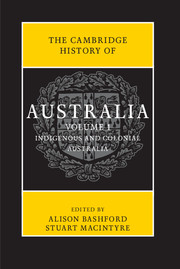Book contents
- Frontmatter
- Contents
- Abbreviations
- List of maps
- List of figures
- List of tables
- Notes on contributors
- Map
- Preface
- Introduction
- PART I
- 1 The past 50,000 years: an archaeological view
- 2 Newcomers, c. 1600–1800
- 3 Convict transportation in global context, c. 1700–88
- 4 The early colonial presence, 1788–1822
- 5 Expansion, 1820–50
- 6 The advent of self-government, 1840s–90
- 7 The gold rushes of the 1850s
- 8 Colonial states and civil society, 1860–90
- 9 Rethinking the 1890s
- 10 Making the federal Commonwealth, 1890–1901
- PART II
- Further reading
- Chronology
- Index
- Frontmatter
- Contents
- Abbreviations
- List of maps
- List of figures
- List of tables
- Notes on contributors
- Map
- Preface
- Introduction
- PART I
- PART II
- Further reading
- Chronology
- Index
5 - Expansion, 1820–50
from PART I
Published online by Cambridge University Press: 05 November 2013
- Frontmatter
- Contents
- Abbreviations
- List of maps
- List of figures
- List of tables
- Notes on contributors
- Map
- Preface
- Introduction
- PART I
- 1 The past 50,000 years: an archaeological view
- 2 Newcomers, c. 1600–1800
- 3 Convict transportation in global context, c. 1700–88
- 4 The early colonial presence, 1788–1822
- 5 Expansion, 1820–50
- 6 The advent of self-government, 1840s–90
- 7 The gold rushes of the 1850s
- 8 Colonial states and civil society, 1860–90
- 9 Rethinking the 1890s
- 10 Making the federal Commonwealth, 1890–1901
- PART II
- Further reading
- Chronology
- Index
- Frontmatter
- Contents
- Abbreviations
- List of maps
- List of figures
- List of tables
- Notes on contributors
- Map
- Preface
- Introduction
- PART I
- PART II
- Further reading
- Chronology
- Index
Summary
The settlement of Australia on a continental scale was unimaginable in 1820. Yet by 1850 the continent had been transformed by Europeans and their domesticated animals, and the Australian colonies ranked, with other Anglophone settler societies, among the fastest growing economies in history. Rapid expansion in Australia was neither organic nor inevitable. It was contingent on ecological limits and global political and economic contexts, and was contested by imperial and colonial governments, by excluded settlers and, most of all, by Indigenous people.
Early expansion, 1822–27
In New South Wales, vital groundwork for expansion was laid during the administration of Governor Lachlan Macquarie (1810–21). First, at the end of the Napoleonic wars, Britain appeared to rediscover its convict colony; an influx of convict transports after 1815 increased the tiny local workforce dramatically. Second, there had been important geographic discoveries in the Macquarie era. Driven by overstocking, drought and caterpillar plagues, settlers had crossed the Cowpastures and moved south-west into the cooler climes of Bargo Brush and Sutton Forest, and then beyond, towards the foot-hills of the southern tablelands. Isolated pockets of coastal settlement had also proliferated, to the south on the Illawarra plains and north at Newcastle, where the colony's old penal settlement had grown into an industrial centre supporting around 1,000 prisoners. An overland route from the Hawkesbury River to the lower Hunter Valley, north of Newcastle, paved the way for expansion into what would soon be one of the colony's most productive agricultural districts. Most important, however, was the breaching of the Blue Mountains west of Sydney, that great physical and perceptual boundary that had long defined the colony's horizon. By 1818 a long, sinuous road had been carved across the sandstone ridges of the Great Dividing Range, descending onto the Bathurst plains where two great waterways, the Lachlan and Macquarie rivers, flowed enticingly inland.
- Type
- Chapter
- Information
- The Cambridge History of Australia , pp. 121 - 148Publisher: Cambridge University PressPrint publication year: 2013
- 7
- Cited by



